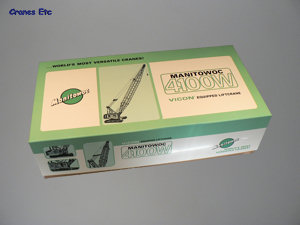 | | The Manitowoc 4100W box. | 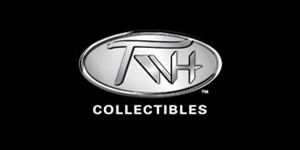 | 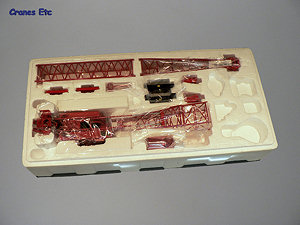 | | The model in the tray. The unfilled gaps are filled in the later variants of the model. | 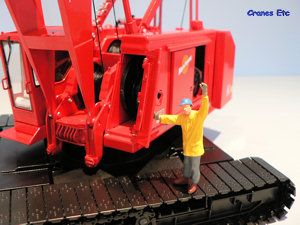 | | Opening door to provide storage for chains. | 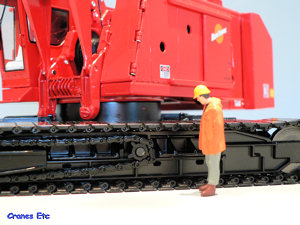 | | Excellent track details and working chain drive. | 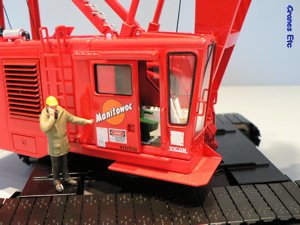 | | Sliding door to the very detailed cab. | 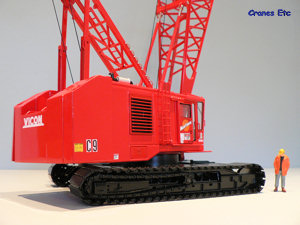 | | Faithful rendition of the 4100W shape. | 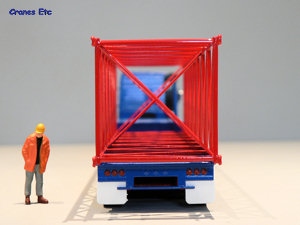 | | Boom sections are dead straight and have internal bracing. | 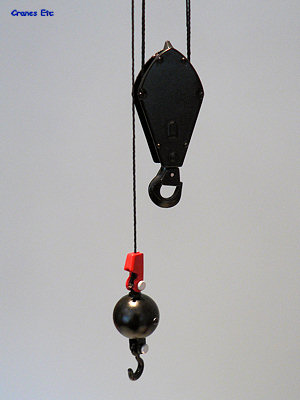 | | Both hooks are good quality. | 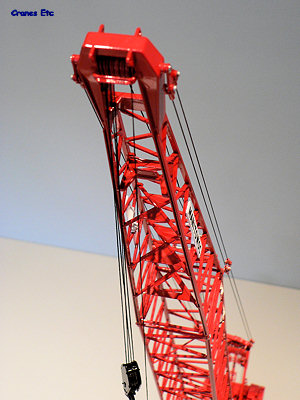 | | The internal bracing on the boom top section is model engineering at its best. | 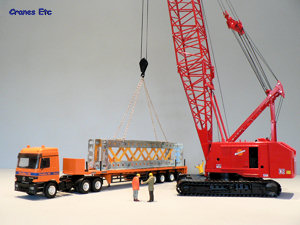 | | 'This truss beam was driven here from Germany...' | 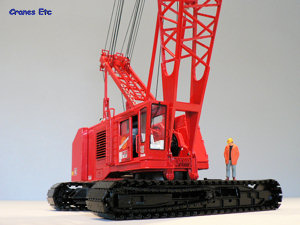 | | A very impressive model overall. |
| The Manitowoc 4100W is a famous crane in the history of the Manitowoc Crane Company and was one of the most popular cranes it ever built. It was launched in 1968 and was in production until the mid 1990s with nearly a thousand having been made.
This model is the crawler crane version which had a lifting capacity of 200 tons.
Packaging
The model comes in an interesting box which harks back to the era when the crane was first produced. It consists of a top and bottom cardboard piece and unusually the instructions for building the model are printed on the inside of the lid. Within the box is a single expanded polystyrene tray with lid which contains the pieces of the model, all well wrapped in polythene. The review model was undamaged.
The instructions are simple and straightforward to follow. In fact if anything they are too simple as they do not fully explain all assembly tasks such as the raising of the gantry which would be helpful to a novice collector. A Manitowoc branded screwdriver (complete with the appropriate aged logo) is supplied to assist the assembly. To make things easier for collectors the boom luffing ropes are reeved in the factory. It is recommended that before the model is assembled that some plastic putty or similar material is pressed on to the pulleys to stop the string bouncing off whilst undoing the tape which has been used to hold the strings together during packing and transport. Around ninety minutes should be allowed to build the model fully.
Also provided is a reproduction of a 1969 brochure which contains the specifications and load charts for the original crane.
Detail
Getting the model out of the box it is clear Manitowoc have invested in a high quality model to celebrate the 4100W.
The metal linked tracks are excellent and the track frames are very detailed. Particularly fine points are the spoked drive sprockets and the realistic working chain drives which move as the tracks are used. The undercarriage frame has attachable ballast boxes and these include patterned steps and tiny warning notices. The ballast boxes are not particularly heavy, although the undersides can be unscrewed allowing additional weight to be added.
The crane body impresses because of the fine paintwork and graphics. The cab is fully detailed inside with seat and control levers, and the details continue outside with patterned walkways, windscreen wiper and grab handles. The cab door has some exceptionally fine graphics applied.
Behind the cab is a metal ladder leading to the roof and behind that is a fine slatted grille. At the rear, the counterweight blocks are smoothly finished. Opposite the driver’s cab side is another sliding door and this reveals the engine compartment complete with various pipe work. At the front, the structure for supporting the boom pivot is very nicely reproduced.
The roof of the crane body has an exhaust with chrome muffler, and the gantry structure is very well detailed with step irons leading to a ladder which provides access to the top of the gantry. All pulleys are metal and the model engineering in this area is high quality.
Collectors will notice that the luffing rope has been knotted within the equaliser and this is due to the way the string has been reeved from the twin drums of the luffing winch as two separate pieces. In practice this does not detract from the look of the model too much – on the review model at least.
The boom sections are very good and represent the Boom No 22 of the original, together with the optional 4˝° offset boom top. The boom butt section has two metal cylinders which restrain the jib from over-luffing, and the casting overall of all boom sections is very good with the main chord members cast to replicate the inverted angled sections of the original. Main boom sections all have internal bracing which is an unusual detail in crane models. The screwed connections between sections are good and positive.
The boom top section is excellent. It was designed on the real crane in such a way that the boom can be at a very steep angle without the lines to the hook being fouled and so some complicated fabrication was involved to produce the required profile. The model replicates this perfectly and at the time of the review this is probably the best lattice work boom section seen by Cranes Etc. Metal pulleys and Manitowoc sign boards complete the piece.
Pendants are string and have metal connections and a good job has been done to keep the lengths of pendants the same. Perhaps the only surprise is that the pendant connections between two lines are riveted rather than screwed meaning that to display the model with a short jib means the rivets have to be drilled or cut out.
Two hooks are supplied. A headache ball has a realistic connector and the hook itself rotates. The main block has four free rolling sheaves and the hook has a working safety catch which is an excellent feature.
Features
The track frames are screwed and detachable from the main undercarriage and can be refixed at a slightly narrower transport configuration, although this was not tried on the review model.
The counterweight is supplied as a number of pieces which push-fit together and fit to the crane body. With a little effort the crane can be posed in a realistic travelling configuration on a suitable low loader.
In addition to the sliding doors and opening chain case there is an opening hatch on the roof which allows a view into the engine compartment.
The presented model has an offset boom but this is easily adjusted to a normal boom by removing the small offset fishplates which are included on the boom head section.
The crane functions all work well. Rotation of the crane is smooth. The luffing and hoist drums are operated using a key which inserts through holes in the bodywork and these work fine, not slipping under load.
Quality
This model exudes the feel of a quality product. The paintwork and decals are high quality and the manufacture and presentation of the model is in the same category. There is pretty much a complete absence of plastic.
Price
This model is very good value for the quality of what is offered.
Overall
As a representation of a famous historic crane it is pleasing to see that such a fine effort has been made to produce a model that lives up to its full size brother. There are a few minor points for improvement but these really are minor and overall this is a first class model and deserves its high rating on Cranes Etc.
Footnotes
The model first appeared at the end of 2007. The run of the model is 2500. A version with the markings of Essex Crane has been produced in a run of 250 models. It is marketed outside the Americas by NZG as model number 692. A boom extension kit is available for the model including two 40ft boom sections and one 10ft boom section. A second extension kit includes a #123 Jib. Other variants of the 4100W model produced: dragline/clamshell/magnet, ringer and tower crane. |
| |
| 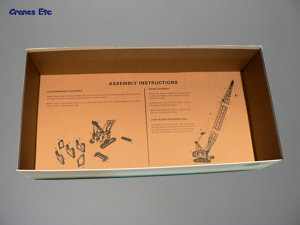 | | Inside the lid are the simple instructions.. | 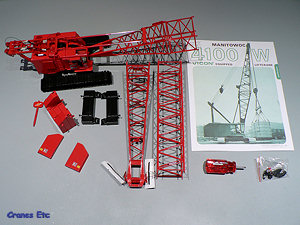 | | The parts out of the box. | 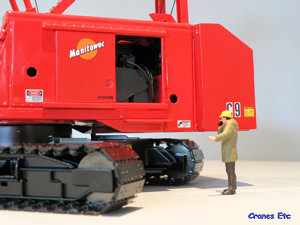 | | Sliding door reveals the engine compartment. | 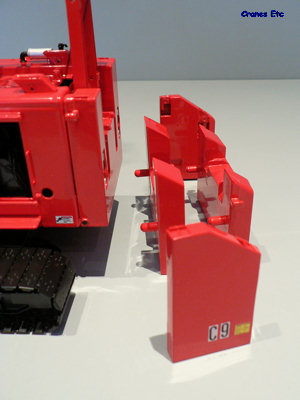 | | Counterweight attaches in pieces. | 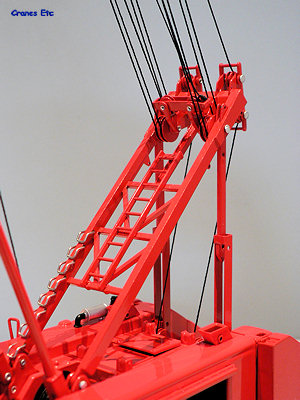 | | Detailed gantry with metal pulley sheaves. The knotted string can just be seen by looking hard in the area of the equaliser. | 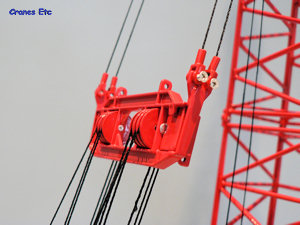 | | Well engineered parts. | 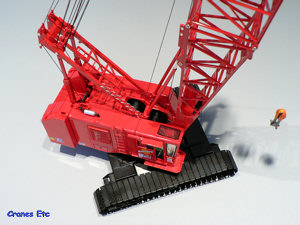 | | Great detail all around. | 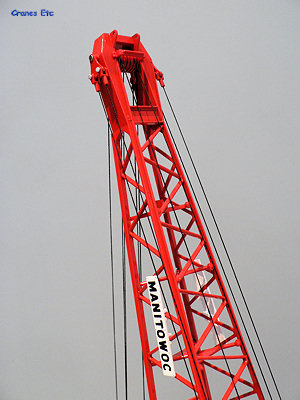 | | Excellent boom top. | 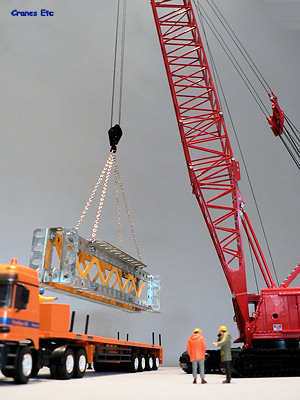 | | The model 4100W lifts with ease. Here the 4100W is posed with the Goldhofer Telescopic Trailer. |
|

